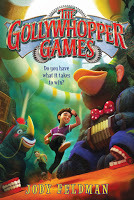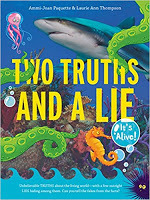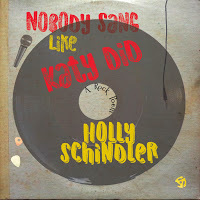Marcia Thornton Jones's Blog, page 128
November 11, 2017
The Games Writers Play (at least this writer)
by Jody Feldman
 It was too many years ago to remember exactly when this happened.
It was too many years ago to remember exactly when this happened.
I was on my first draft, as I recall, of The Gollywhopper Games and had lost steam that particular day. “Just write one page,” I urged myself. “Just one.”
In my mind, it was already huge that I’d gotten this far in the story. I’d imagined myself a picture book author, but that's another tale for another day. So I made myself a deal. I could quit for the day if I wrote one page. And for further encouragement, I challenged myself: Finish the physical page I was on then write the next—one single page—using every letter of the alphabet without my invoking the quick brown fox jumps over the lazy dog. And without having my character recite the ABCs. And without veering the plot in a weird direction. This had to be done with careful word choice.
The game was challenging. The game was fun. I won the game, and not just because I’d managed to complete the task. While I did write an extra couple pages that day, more important, I learned that a little mindfulness made me a better writer. That page may have been my best to date.
I’ve played other games along the way. I mean, c’mon. I’m that person who, so far, has included puzzles in every one of her books. I can’t say I’d go as far as doing something like this, probably not even with the letter M. But I am playing the ultimate (at least in my book, so to speak) novelist’s game.
Never did I ever entertain the idea of doing NaNoWriMo, writing an entire 50,000-word novel during the month of November. Yet, here I am, halfway done, according to their goal. My first drafts, however, usually come in upwards of 60,000 words. That toughens the game. And to make it even harder for me this year, I'm adding in several travel days, NCTE, company for Thanksgiving, a Skype, a webinar, doctors’ appointments, life. And hey! I’ve just wasted, to this point, 356 words on this blog entry. Sorry. Would love to play longer, but I’ve gotta...

 It was too many years ago to remember exactly when this happened.
It was too many years ago to remember exactly when this happened.I was on my first draft, as I recall, of The Gollywhopper Games and had lost steam that particular day. “Just write one page,” I urged myself. “Just one.”
In my mind, it was already huge that I’d gotten this far in the story. I’d imagined myself a picture book author, but that's another tale for another day. So I made myself a deal. I could quit for the day if I wrote one page. And for further encouragement, I challenged myself: Finish the physical page I was on then write the next—one single page—using every letter of the alphabet without my invoking the quick brown fox jumps over the lazy dog. And without having my character recite the ABCs. And without veering the plot in a weird direction. This had to be done with careful word choice.
The game was challenging. The game was fun. I won the game, and not just because I’d managed to complete the task. While I did write an extra couple pages that day, more important, I learned that a little mindfulness made me a better writer. That page may have been my best to date.
I’ve played other games along the way. I mean, c’mon. I’m that person who, so far, has included puzzles in every one of her books. I can’t say I’d go as far as doing something like this, probably not even with the letter M. But I am playing the ultimate (at least in my book, so to speak) novelist’s game.
Never did I ever entertain the idea of doing NaNoWriMo, writing an entire 50,000-word novel during the month of November. Yet, here I am, halfway done, according to their goal. My first drafts, however, usually come in upwards of 60,000 words. That toughens the game. And to make it even harder for me this year, I'm adding in several travel days, NCTE, company for Thanksgiving, a Skype, a webinar, doctors’ appointments, life. And hey! I’ve just wasted, to this point, 356 words on this blog entry. Sorry. Would love to play longer, but I’ve gotta...

Published on November 11, 2017 04:00
November 8, 2017
READERS WANT TO HAVE FUN by Jane Kelley
by JANE KELLEY
Sometimes writing a book feels like an awful lot of work. There are so many tasks to accomplish. Writers have to establish the character, build the world, raise the stakes, advance the plot, develop the character, add some subplots--just to name a few of them.
When I work on a project, I can get so focused on tackling this checklist that I forget an important element. So I've added another item. Remember to put in some fun!
This may seem kind of obvious, but I've read many well-intentioned MG novels that only succeed in dutifully following the rules.
What do I mean by putting in fun?
1. Make necessities an opportunity for invention.
In my chapter book, Clint McCool needed to be picked up from school. This task could have been accomplished by any adult--even his mom. But where's the fun in that? I decided to give the job to the worst possible person--his old babysitter.

Meet Mrs. Brussels (so wonderfully drawn by Jessika von Innerebner). Mrs. Brussels knows every embarrassing thing about Clint McCool--including what was in his diapers. I was shameless. I put in a few poop jokes. But fun isn't limited to being funny.
2. Savor the moment. Don't rush through those good parts. Use all your senses to enjoy them. Is your character eating ice-cream? Discovering a ghost in the closet? Swimming with dolphins? Well, we want to do that too. So make sure you let us.
3. Put in puppies and kittens--or any adorable thing.They're cute! They're comical! Who doesn't love them? Who wouldn't stop to pet one no matter how busy they were advancing the plot?
4. Geek out.Kids really do like learning things. Add in a few fun facts about Greek heroes or gross viruses, or whatever your character might have wanted to find out.
5. Defeat the bully.Give us a little satisfaction. It's fun to see the pompous jerk slip on that banana peel -- even if he or she will get back up to cause the crisis.
6. Indulge us.
Sometimes I think of a novel as a Christmas tree. It needs to have a trunk and branches. It needs a stand. I have to remember to water it. But what would the tree be without those colorful baubles? My apologies for inserting Christmas in November's post. But I couldn't figure out how to make a turkey fun. Can you?
My apologies for inserting Christmas in November's post. But I couldn't figure out how to make a turkey fun. Can you?
Sometimes writing a book feels like an awful lot of work. There are so many tasks to accomplish. Writers have to establish the character, build the world, raise the stakes, advance the plot, develop the character, add some subplots--just to name a few of them.
When I work on a project, I can get so focused on tackling this checklist that I forget an important element. So I've added another item. Remember to put in some fun!
This may seem kind of obvious, but I've read many well-intentioned MG novels that only succeed in dutifully following the rules.
What do I mean by putting in fun?
1. Make necessities an opportunity for invention.
In my chapter book, Clint McCool needed to be picked up from school. This task could have been accomplished by any adult--even his mom. But where's the fun in that? I decided to give the job to the worst possible person--his old babysitter.

Meet Mrs. Brussels (so wonderfully drawn by Jessika von Innerebner). Mrs. Brussels knows every embarrassing thing about Clint McCool--including what was in his diapers. I was shameless. I put in a few poop jokes. But fun isn't limited to being funny.
2. Savor the moment. Don't rush through those good parts. Use all your senses to enjoy them. Is your character eating ice-cream? Discovering a ghost in the closet? Swimming with dolphins? Well, we want to do that too. So make sure you let us.
3. Put in puppies and kittens--or any adorable thing.They're cute! They're comical! Who doesn't love them? Who wouldn't stop to pet one no matter how busy they were advancing the plot?
4. Geek out.Kids really do like learning things. Add in a few fun facts about Greek heroes or gross viruses, or whatever your character might have wanted to find out.
5. Defeat the bully.Give us a little satisfaction. It's fun to see the pompous jerk slip on that banana peel -- even if he or she will get back up to cause the crisis.
6. Indulge us.
Sometimes I think of a novel as a Christmas tree. It needs to have a trunk and branches. It needs a stand. I have to remember to water it. But what would the tree be without those colorful baubles?
 My apologies for inserting Christmas in November's post. But I couldn't figure out how to make a turkey fun. Can you?
My apologies for inserting Christmas in November's post. But I couldn't figure out how to make a turkey fun. Can you?
Published on November 08, 2017 03:00
November 5, 2017
Improvisation Writing by Deborah Lytton
Before I was an author, I was an actor. I worked in television and films from the age of six all the way through high school. Most of my acting training occurred on the job. However, in my twenties, I began studying improvisation at The Second City and then The Groundlings in Hollywood. I met so many talented actors both as teachers and fellow students and they inspired and challenged me in my work. What I learned was how to write and act without boundaries. As with all acting skills, improvisation techniques are quite structured and seem to contrast with the spontaneity of the improv itself. This type of work demands quick thinking and a willingness to let go of expectations and self-imposed restrictions. Best of all, it is great fun. The closest thing I can compare it to is play. When children play, they make up stories with complete freedom and without expectation or self-consciousness. However, the games always have their own structure. The exercises for improv are even called "Games" and they range from talking in gibberish to miming a scene. As writers, we can learn a great deal from improv itself. For if we can abandon ourselves to the words on the page and allow the story to unravel itself, we are improvising just as if we were standing on a stage in Hollywood. Challenging ourselves to piece together our story through different perspectives and voices will help us hone the narrative. If we can play as we write, then we will find ourselves reaching beyond our own limitations to truly free our imaginations. So today, play with your characters, your setting, and your plot. Release your expectations and just improv through the scene. See what you can write when you let go.
Published on November 05, 2017 21:23
November 3, 2017
Got Writers' Block? Time to PLAY
 We writers put a lot of pressure on ourselves. We worry over word counts and writing goals and book sales. We want to Achieve! Produce! Succeed! And sometimes all this pressure can separate us from THE thing that drew us to this word-work in the first place: the joy of playing with words.
We writers put a lot of pressure on ourselves. We worry over word counts and writing goals and book sales. We want to Achieve! Produce! Succeed! And sometimes all this pressure can separate us from THE thing that drew us to this word-work in the first place: the joy of playing with words.As a poet, word-play is part of the job description. Every poem is like a playground complete with swing and see-saw and slide. We can move words from line to line, divide lines into stanzas, make-up and replace words with other (better!) words. Well, guess what? Prose writers can – and should – do the same thing. It's not all about plot and character development. It's about PLAY.
Here are a few ways to incorporate play into your writing life:
Take a Dictionary Hike. Go to a dictionary page, close your eyes, and point. Incorporate into a sentence whatever word your finger lands on. In 2012 Amy Ludwig VanDerwaterdid this for National Poetry Month.
 Play Wreck That Cliche. Take any cliché – “it's raining cats and dogs,” for instance – and wreck it. Make it your own! It's pouring chainsaws and hammers... boots and umbrellas... leaves and acorns (actually, it really IS raining leaves and acorns outside my window today. See? PLAY.)
Play Wreck That Cliche. Take any cliché – “it's raining cats and dogs,” for instance – and wreck it. Make it your own! It's pouring chainsaws and hammers... boots and umbrellas... leaves and acorns (actually, it really IS raining leaves and acorns outside my window today. See? PLAY.)Gender Bender. Change the gender of your main character.
Plot Twist. Wherever you are in your story, see what happens if your main character comes into some unexpected money.
Name Game. Write a story about a character whose name is a vegetable... what adventures would Zucchini Smith have?
Free Write. This is not a new idea, but it's always a good one. Just WRITE. Without thinking. Without goal. Without destination. Let your brain onto the playground!
Write Backwards. Start your story at THE END and see what happens!
 The Purple Horse Poetry Studio
The Purple Horse Poetry Studioand Music RoomWalk/Play an Instrument/Vacuum/Insert Your Hobby Here. One of the ways I play as a writer is to go spend some quality time with my cello. As my body moves to produce music, I am released from all that expectation. It's like being at the tip-top of the swing when the chain has that moment of “give.” It's why my studio is also a music room.
Happy Playing!-------------------- IreneLatham is the author of more than a dozen current and forthcoming poetry, fiction and picture books for children and adults, including Leaving Gee's Bend, 2011 ALLA Children's Book of the Year and her latest Can I Touch Your Hair? Poems of Race, Mistakes and Friendship (co-written with Charles Waters). Winner of the 2016 ILA Lee Bennett Hopkins Promising Poet Award, she lives in Birmingham, Alabama with her family where she does her best to “live her poem” every single day by laughing, playing the cello, and walking in the woods.
Published on November 03, 2017 03:30
November 2, 2017
Finding Your Peeps by Ann Haywood Leal
When I was teaching and I needed to brainstorm about a lesson or a student, or just plain vent, all I had to do was to go next door or across the hall and I automatically had an eager and sympathetic ear.
 This can be difficult as a writer, especially if you are juggling your writing time. We do what we have to do, sometimes piecemealing it from dashes of the early morning and late night. And we are almost always doing this completely solo.
This can be difficult as a writer, especially if you are juggling your writing time. We do what we have to do, sometimes piecemealing it from dashes of the early morning and late night. And we are almost always doing this completely solo.
But if I dash across the hall to brainstorm or do some writerly venting at my house, I'm most likely to just find Boo Radley and Charlie Bucket. While I adore my cats, they aren't the best at providing feedback. And frankly, they can be a bit judgmental with those fixed eyes . . .
 If you are lucky enough to have a critique group who meet on a regular basis, make sure you do just that. Make it a priority. Show up-- not just for the others in your group, but for yourself.
If you are lucky enough to have a critique group who meet on a regular basis, make sure you do just that. Make it a priority. Show up-- not just for the others in your group, but for yourself.
 But what if you just can't wrangle it, and your location or your day job or most commonly, your family situation doesn't allow much time to breathe, much less travel somewhere to write?
But what if you just can't wrangle it, and your location or your day job or most commonly, your family situation doesn't allow much time to breathe, much less travel somewhere to write?
I am a HUGE fan of Skype and/or FaceTime. Your writing partners can be on a completely different continent, and if you can figure out the time difference, you don't have to move an inch.
I am so very thankful for my writing peeps--all of the wonderful women and men who make my profession less solitary. They can be the difference between a bout of the dreaded writer's block and having an inspired morning of writing.
I love to picture J.K. Rowling, writing in a coffee shop with one hand, while rocking her baby with the other. She made it work--boy, did she make it work.
And you can, too!
 This can be difficult as a writer, especially if you are juggling your writing time. We do what we have to do, sometimes piecemealing it from dashes of the early morning and late night. And we are almost always doing this completely solo.
This can be difficult as a writer, especially if you are juggling your writing time. We do what we have to do, sometimes piecemealing it from dashes of the early morning and late night. And we are almost always doing this completely solo.But if I dash across the hall to brainstorm or do some writerly venting at my house, I'm most likely to just find Boo Radley and Charlie Bucket. While I adore my cats, they aren't the best at providing feedback. And frankly, they can be a bit judgmental with those fixed eyes . . .
 If you are lucky enough to have a critique group who meet on a regular basis, make sure you do just that. Make it a priority. Show up-- not just for the others in your group, but for yourself.
If you are lucky enough to have a critique group who meet on a regular basis, make sure you do just that. Make it a priority. Show up-- not just for the others in your group, but for yourself.
 But what if you just can't wrangle it, and your location or your day job or most commonly, your family situation doesn't allow much time to breathe, much less travel somewhere to write?
But what if you just can't wrangle it, and your location or your day job or most commonly, your family situation doesn't allow much time to breathe, much less travel somewhere to write?I am a HUGE fan of Skype and/or FaceTime. Your writing partners can be on a completely different continent, and if you can figure out the time difference, you don't have to move an inch.
I am so very thankful for my writing peeps--all of the wonderful women and men who make my profession less solitary. They can be the difference between a bout of the dreaded writer's block and having an inspired morning of writing.
I love to picture J.K. Rowling, writing in a coffee shop with one hand, while rocking her baby with the other. She made it work--boy, did she make it work.
And you can, too!
Published on November 02, 2017 11:45
November 1, 2017
October 28, 2017
What Do They Really Want?
By Charlotte Bennardo
Authors try to keep up on the trends and 'wish lists' of editors and agents. In the midst of agent/editor subbing, I did an informal, unscientific, partial list review of the Manuscript Wish List- to get a general (again, unscientific, not to be etched in stone) look see to find out what they want.
First, they all generally said what they wanted most was (obviously) "strong characters, distinct voices, great story telling." The next most used buzz words were magic/magical realism/mythology, which frankly surprised me, because authors have been hearing that magic and fantasy is so done, yet I've been to conferences with both agents and editors where I've heard "no more Harry Potter" or the like. But it seems the overall magic genre is still as popular as ever.
The second most popular category was diversity/own voices. I put these two together as they are commonly linked in articles, wish lists, etc. This was no surprise as it's been a big theme in the publishing and academic worlds.
Ranked third on my gander was contemporary. (If an editor specified contemporary magic, I lumped that in the magic category, not the more general contemporary.) Gender issues and horror/ supernatural appeared next.
What surprised me the most? That STEM/STEAM was at the bottom of the number of requests; even historicals, family, mysteries, and humor rated higher. With the emphasis on falling science/ technology/engineering/math test scores, college grads, and jobs, that this would have been higher. At a number of book events I hear a lot of push for STEM/STEAM books.
There was only one request for a 'before & after' story, a few for literary over commercial fiction, and one with 'no western settings.' (I guess there's a lot of that? So no more stories like Stephen King's The Gunslinger?)
While many agents/editors qualified their lists with "if it has a unique perspective" or "has an unreliable protagonist" or "makes me cry/laugh/get emotional" it's a safe bet that if a specific category isn't on their list, they're probably not interested; an editor/agent with a penchant for issue or contemporary novels could be turned off by sci fi.
The overall consensus: write what you want, what you can, and write it well. Then sort through the agents and editors.
Authors try to keep up on the trends and 'wish lists' of editors and agents. In the midst of agent/editor subbing, I did an informal, unscientific, partial list review of the Manuscript Wish List- to get a general (again, unscientific, not to be etched in stone) look see to find out what they want.
First, they all generally said what they wanted most was (obviously) "strong characters, distinct voices, great story telling." The next most used buzz words were magic/magical realism/mythology, which frankly surprised me, because authors have been hearing that magic and fantasy is so done, yet I've been to conferences with both agents and editors where I've heard "no more Harry Potter" or the like. But it seems the overall magic genre is still as popular as ever.
The second most popular category was diversity/own voices. I put these two together as they are commonly linked in articles, wish lists, etc. This was no surprise as it's been a big theme in the publishing and academic worlds.
Ranked third on my gander was contemporary. (If an editor specified contemporary magic, I lumped that in the magic category, not the more general contemporary.) Gender issues and horror/ supernatural appeared next.
What surprised me the most? That STEM/STEAM was at the bottom of the number of requests; even historicals, family, mysteries, and humor rated higher. With the emphasis on falling science/ technology/engineering/math test scores, college grads, and jobs, that this would have been higher. At a number of book events I hear a lot of push for STEM/STEAM books.
There was only one request for a 'before & after' story, a few for literary over commercial fiction, and one with 'no western settings.' (I guess there's a lot of that? So no more stories like Stephen King's The Gunslinger?)
While many agents/editors qualified their lists with "if it has a unique perspective" or "has an unreliable protagonist" or "makes me cry/laugh/get emotional" it's a safe bet that if a specific category isn't on their list, they're probably not interested; an editor/agent with a penchant for issue or contemporary novels could be turned off by sci fi.
The overall consensus: write what you want, what you can, and write it well. Then sort through the agents and editors.
Published on October 28, 2017 21:04
October 27, 2017
NaNoWriMo is Almost Here!
Has a book idea been nagging you for a while now? Well, it might be time to stop thinking about it and put it down on paper because National Novel Writing Month starts on Wednesday. If you’re not familiar with NaNoWriMo, it’s a month-long event that takes place every November. The goal of NaNoWriMo is to write a 50,000 word novel from November 1-30. The website, nanowrimo.org, has resources to help inspire you, and it also awards various writing badges. Seriously, badges. You know you want one.
Need further motivation? A lot of NaNoWriMo novels have gone on to land publishing deals including Water for Elephants by Sara Gruen, The Night Circus by Erin Morgenstern, and Fangirlby Rainbow Rowell. And although 50,000 words is a bit short for an adult novel, it’s a great length for middle grade if that’s your genre.
I decided to tackle NaNoWriMo exactly three years ago this Wednesday after my cousin, and fellow scribe, posed a challenge for someone to join her in doing it. I’d never participated before, but I’d had this idea in my head for over a year. It was one of those ideas that takes hold of your brain and refuses to let go no matter how much you tell it to leave you alone.
I decided my cousin’s challenge was just the push I needed to finally put this idea down on paper. After all, I’d been thinking about these characters and this story for so long, it was like I knew them already. I furiously wrote every day that month. I didn’t reach 50,000 words, so I guess I didn’t technically win NaNoWriMo. But I did finish my very first middle grade novel, complete at 32,000 words.
A NaNoWriMo book is the roughest of first drafts, and mine was no exception. I worked for a few months on revising that NaNoWriMo book until I felt comfortable sending it out to literary agents. The feedback I got was that it needed more revisions. Fast-forward about eight months, 15,000 more words, and a complete and total rewrite later, and I had my agent. That book, Insignificant Events in the Life of a Cactus, is on book store shelves today. And I’m not sure it would have happened if it weren’t for NaNoWriMo.
Sometimes all we need is a little encouragement, a little shove, to get going on a story. NaNoWriMo can be that shove you need this November. If you think you might be ready to attack that idea of yours, go to nanowrimo.org right now and get moving.
Need further motivation? A lot of NaNoWriMo novels have gone on to land publishing deals including Water for Elephants by Sara Gruen, The Night Circus by Erin Morgenstern, and Fangirlby Rainbow Rowell. And although 50,000 words is a bit short for an adult novel, it’s a great length for middle grade if that’s your genre.
I decided to tackle NaNoWriMo exactly three years ago this Wednesday after my cousin, and fellow scribe, posed a challenge for someone to join her in doing it. I’d never participated before, but I’d had this idea in my head for over a year. It was one of those ideas that takes hold of your brain and refuses to let go no matter how much you tell it to leave you alone.
I decided my cousin’s challenge was just the push I needed to finally put this idea down on paper. After all, I’d been thinking about these characters and this story for so long, it was like I knew them already. I furiously wrote every day that month. I didn’t reach 50,000 words, so I guess I didn’t technically win NaNoWriMo. But I did finish my very first middle grade novel, complete at 32,000 words.
A NaNoWriMo book is the roughest of first drafts, and mine was no exception. I worked for a few months on revising that NaNoWriMo book until I felt comfortable sending it out to literary agents. The feedback I got was that it needed more revisions. Fast-forward about eight months, 15,000 more words, and a complete and total rewrite later, and I had my agent. That book, Insignificant Events in the Life of a Cactus, is on book store shelves today. And I’m not sure it would have happened if it weren’t for NaNoWriMo.
Sometimes all we need is a little encouragement, a little shove, to get going on a story. NaNoWriMo can be that shove you need this November. If you think you might be ready to attack that idea of yours, go to nanowrimo.org right now and get moving.
Published on October 27, 2017 22:00
October 26, 2017
UPDATE: EDUCATORS' RESOURCE - TWO TRUTHS AND A LIE

Back in June, we introduced you to Ammi-Joan Paquette and Laurie Ann Thompson's fun new non-fiction MG book, TWO TRUTHS AND A LIE.
We're delighted to also share that the book now has an educators' resource, which can be found here.
Published on October 26, 2017 05:00
October 25, 2017
TAKING A CHANCE (HOLLY SCHINDLER)

I took a few chances on my latest picture book, NOBODY SANG LIKE KATY DID. The book is blend of things that, at first blush, shouldn’t go together:
Poetry and rock ‘n roll: The book itself is a story in verse, and the main character is a singer in her own rock band.
Katydids and singing: Of all the creatures on this earth, katydids are not exactly what you’d consider great singers. To me, their voices sound like creaky screen doors opening over and over! And yet, the main character of NOBODY SANG LIKE KATY DID is, in fact, a katydid.
Kids and formal poetry: Poetry, some think, is stuffy. Or hard. And formal poetry? For young readers? And yet, the book is itself a villanelle, a form most readers don’t encounter until later school years, when they read Thomas’s “Do not go gently into that good night,” arguably the most famous villanelle written.
Photos and illustration: Each page of the book contains watercolor illustrations merged with photographic elements.
The thing is, though, mixing up pieces that seem like they belong to two different worlds is, I think, where absolute magic happens. We see things in a new way. We realize some of the best rock songs are really like three-minute poems (and the repeating lines of the villanelle is like the repeating chorus of a rock song). We realize that for kids who are MG readers, straddling the line between grown-up ideas and younger interests, photos and illustrations can make the perfect combination. We realize that the best singing voices are like Katy’s—not technically perfect, but full of soul. And, most importantly, we realize that finding new ways to make poetry (even formal poetry!) accessible to young readers means that they won’t be intimidated by it as adults. We help foster a lifelong love and appreciation of poetry.
Take a chance—find a new “odd-couple” pairing to put in your own WIP!
And check out more about NOBODY SANG LIKE KATY DID at my #SCBWIBookStop page.
Published on October 25, 2017 13:13



